Found functions
Photographs of curves found in nature and the graphs and functions that go with them.
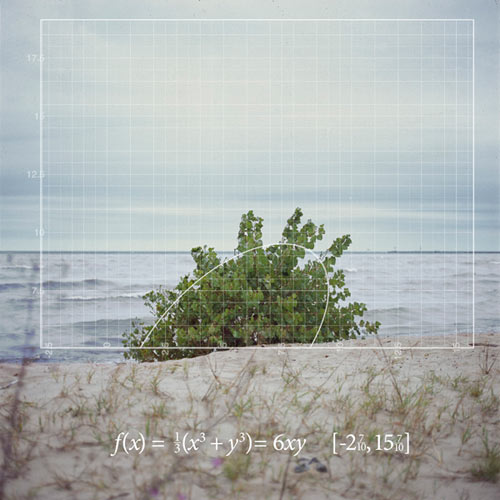
(via snarkmarket)



This site is made possible by member support. 💞
Big thanks to Arcustech for hosting the site and offering amazing tech support.
When you buy through links on kottke.org, I may earn an affiliate commission. Thanks for supporting the site!
kottke.org. home of fine hypertext products since 1998.
Photographs of curves found in nature and the graphs and functions that go with them.

(via snarkmarket)
Clever idea: you can measure the amount of ink required to print different typefaces simply by writing them out with ballpoint pens. The pens themselves become the usage graph:

Update: You can also use this technique to represent which colors you draw with most often.
The most interesting of several infographics related to The Beatles is the first one depicting the declining rate of collaboration within the band gleaned from songwriting credit data.
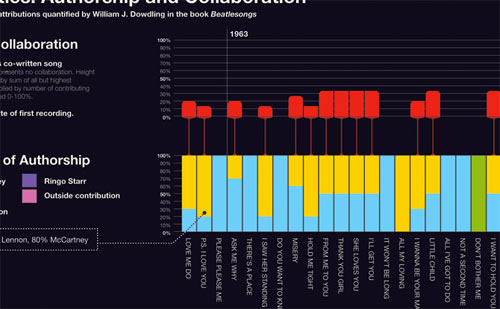
(thx, bryan)
This clever graph by National Geographic shows the cost of healthcare compared to life expectancy in a number of countries. The way that the US healthcare expenditure is pictured entirely outside the confines of the graph’s scale and legend is a particularly effective design decision. (thx, jim)
Today on xkcd, an illustration showing the gravity wells of our solar system’s planets and some of their moons.
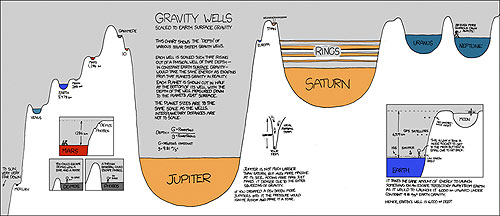
Two of Mars’ tiny moons barely have any gravity at all:
You could escape Deimos with a bike and a ramp. A thrown baseball could escape Phobos.
That’s great, but you forgot Pluto!

One of many from Mary and Matt. It’s a stacked bar chart *and* candy. (via youngna)
New-ish thing from fake is the new real: outlines of the 100 most populous areas in the US. Some are cities and some are states.
The fifty largest metro areas (in blue), disaggregated from their states (in orange). Each has been scaled and sorted according to population.
By themselves, the New York, Los Angeles, and Chicago metros are the three most populous areas in the US. (via snarkmarket)
A visualization of the decline of the world’s four maritime empires (British, Portuguese, French, Spanish) from 1800 to 2009.
France pretty much just explodes around 1960.
A wonderful character interaction map of the Lord of the Rings trilogy drawn by Randall Munroe. Here’s just a little part of it:
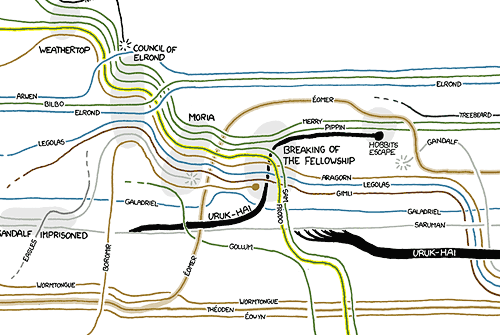
Beautiful map by National Geographic of human exploration of the solar system.

See also Race to the Moon at HistoryShots and Bryan Christie’s Mission(s) to Mars. (thx, byrne)
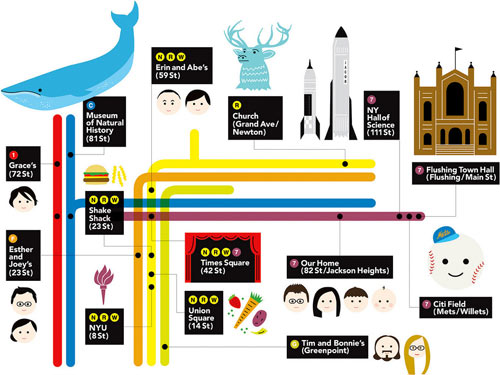
This was my present to my nephew for his 3rd birthday. He loves, loves, loves the subway so my sister asked me if I could make a custom map with all the places that mean something to him on the poster.
Best viewed a bit large.
Update: There’s been a bit of confusion…this is not something that I made. I don’t even have a nephew.
Update: The subway map was made by Erin Jang.
A diagram that shows the overlap of street photography, fine art photography, and photojournalism.
Great interactive graphic from the Times depicting how people spend their time.
A handy flowchart: how to get your photo taken by The Sartorialist. If you’re a man and you have pants: “cuff ‘em, roll ‘em, make ‘em too short”.
Ben Fry just updated his interactive salary vs performance graph that compares the payrolls of major league teams to their records. Look at those overachieving Rays and Marlins! And those underachieving Indians, Mets, and Cubs!
Flip Flop Fly Ball is a marriage of baseball fandom and an enthusiasm for infographics. While not strictly baseball, this comparison of the sizes and shapes of sports balls is a favorite.
A very interesting infographic of the ideological history of the Supreme Court from 1937 to the present. The color coding on the map is weirdly inaccurate but you can still be general trends pretty well…like how many of the justices changed greatly during their terms. William O. Douglas became slightly more moderate mid-term and then got really liberal while Rehnquist went from very conservative to more moderate as his term went on, especially after he became Chief Justice.
OT: I knew there was a Burger on the bench but was unaware of Justice Frankfurter (1938-1961).
Update: Alex Lundry designed the visualization and got in touch to explain the color coding.
The colors are chosen based upon the Min, Max, and Median of the area we are comparing. So, in the first view, the “overall” view, the darkest Red is anchored to the maximum ideology number across all justices and all terms, the darkest Blue is anchored to the minimum score, and the purest white is anchored to the actual median number (The Location of the Median Justice is NOT necessarily the actual median, as it is calculated via a Bayesian statistical estimate).
The second “compare” option, “within each seat, row” calculates separate color anchors for each row.
Similarly, the third compare option, “within each year, column” calculates separate color anchors for each column.
The Location of Median Justice and Court Average are not included in these calculations and their color values are set to what they would be in the overall comparison.
Infographics News collects some lovely infographics from a new Portuguese newspaper called i.
The style of infographics follow the general design created by Javier Errea: no fireworks, modern, compact, with cromatic impact but smart. And the Innovation spirit: “newspapers must be daily magazines”, as Juan Antonio Giner says.
(via max gadney)
Bud Caddell summarizes how to be happy with your work in the form of a Venn diagram consisting of three main overlapping areas: What We Do Well, What We Want to Do, and What We Can Be Paid to Do. (via today and tomorrow)
GOOD Magazine has created an archive of their excellent infographics on Flickr. Lots of inspiration here. (via design observer)
The Indianapolis Star did a really nice car tracker for the Indianapolis 500. Just push play and watch the race unfold. I was struck by how few changes in position there were…you’d think people would be passing each other all the time but that’s just not the case. (thx, nathan)
By Meg Pickard, a graph of the lifespan of Twitter trending topics compares “people talking about #topic” and “people talking about talking about #topic”. Outside of Twitter, this applies to pretty much any popular newsworthy topic…the news quickly moves from “we’re telling you about Topic X” to media coverage of the media coverage of Topic X. See: Twitter’s own coverage in the media currently. (thx, @ davidfg )
Mike Frumin took the NYC subway ridership data from all the way back to 1905 (!!) and graphed it on a map, with a sparkline of the ridership data for each stop. Frumin explains the project a little more here.
The result, after much whacking, is, I think, compelling, but you’ll have to see for yourself. The general idea it that the history of subway ridership tells a story about the history of a neighborhood that is much richer than the overall trend. An example, below, shows the wild comeback of inner Williamsburg, and how the growth decays at each successive stop away from Manhattan on the L train.
Update: Here’s another representation of the same data. In this one, the ridership numbers are represented by the thickness of the subway line.
From a German book called Elektroschutz in Bildern, a collection of illustrations detailing a number of ways that people can get electrocuted and the path that the electricity takes through their bodies.
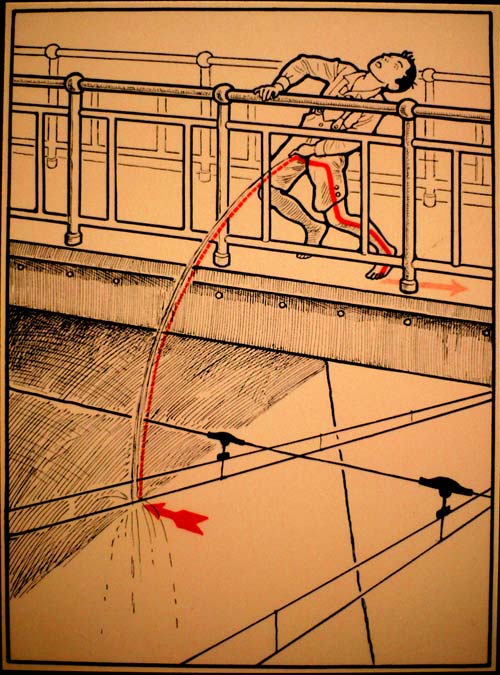
Photo by Bre Pettis. (via jacket mechanical)
Sprint would like to show you a video of what’s happening right now. (via swiss miss)
Good magazine has a nice chart with advice on reducing your water footprint. Meat = really really not good.
Miranda Purves and Jason Logan recently surveyed a bunch of riders of bus and subway lines that the MTA is attempting to eliminate because of a budget crisis. Don’t miss the associated PDF. Related: London tube seat hierarchy and morning subway demographics.
Here’s a handy flowchart to figure out which new media blowhard you are. I am “Try Again”.
Stay Connected